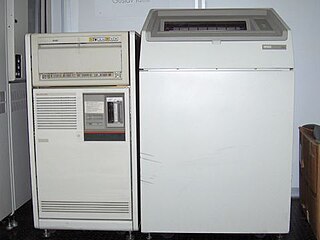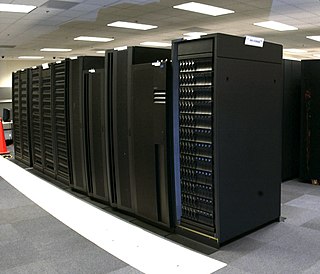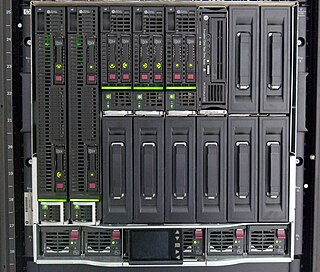
Digital Equipment Corporation, using the trademark Digital, was a major American company in the computer industry from the 1960s to the 1990s. The company was co-founded by Ken Olsen and Harlan Anderson in 1957. Olsen was president until he was forced to resign in 1992, after the company had gone into precipitous decline.

VAX is a series of computers featuring a 32-bit instruction set architecture (ISA) and virtual memory that was developed and sold by Digital Equipment Corporation (DEC) in the late 20th century. The VAX-11/780, introduced October 25, 1977, was the first of a range of popular and influential computers implementing the VAX ISA. The VAX family was a huge success for DEC, with the last members arriving in the early 1990s. The VAX was succeeded by the DEC Alpha, which included several features from VAX machines to make porting from the VAX easier.

Ultrix is the brand name of Digital Equipment Corporation's (DEC) discontinued native Unix operating systems for the PDP-11, VAX, MicroVAX and DECstations.
Pyramid Technology Corporation was a computer company that produced a number of RISC-based minicomputers at the upper end of the performance range. It was based in the San Francisco Bay Area of California

The DECstation was a brand of computers used by DEC, and refers to three distinct lines of computer systems—the first released in 1978 as a word processing system, and the latter two both released in 1989. These comprised a range of computer workstations based on the MIPS architecture and a range of PC compatibles. The MIPS-based workstations ran ULTRIX, a DEC-proprietary version of UNIX, and early releases of OSF/1.

TURBOchannel is an open computer bus developed by DEC by during the late 1980s and early 1990s. Although it is open for any vendor to implement in their own systems, it was mostly used in Digital's own systems such as the MIPS-based DECstation and DECsystem systems, in the VAXstation 4000, and in the Alpha-based DEC 3000 AXP. Digital abandoned the use of TURBOchannel in favor of the EISA and PCI buses in late 1994, with the introduction of their AlphaStation and AlphaServer systems.

The VAXstation is a discontinued family of workstation computers developed and manufactured by Digital Equipment Corporation using processors implementing the VAX instruction set architecture. VAXstation systems were typically shipped with either the OpenVMS or ULTRIX operating systems. Many members of the VAXstation family had corresponding MicroVAX variants, which primarily differ by the lack of graphics hardware.

The R3000 is a 32-bit RISC microprocessor chipset developed by MIPS Computer Systems that implemented the MIPS I instruction set architecture (ISA). Introduced in June 1988, it was the second MIPS implementation, succeeding the R2000 as the flagship MIPS microprocessor. It operated at 20, 25 and 33.33 MHz.

The MicroVAX is a discontinued family of low-cost minicomputers developed and manufactured by Digital Equipment Corporation (DEC). The first model, the MicroVAX I, was first shipped in 1984. They used processors that implemented the VAX instruction set architecture (ISA) and were succeeded by the VAX 4000. Many members of the MicroVAX family had corresponding VAXstation variants, which primarily differ by the addition of graphics hardware. The MicroVAX family supports Digital's VMS, ULTRIX and VAXELN operating systems. Prior to VMS V5.0, MicroVAX hardware required a dedicated version of VMS named MicroVMS.

DEC 3000 AXP was the name given to a series of computer workstations and servers, produced from 1992 to around 1995 by Digital Equipment Corporation. The DEC 3000 AXP series formed part of the first generation of computer systems based on the 64-bit Alpha AXP architecture. Supported operating systems for the DEC 3000 AXP series were DEC OSF/1 AXP and OpenVMS AXP.

The Sony NEWS is a series of Unix workstations sold during the late 1980s and 1990s. The first NEWS machine was the NWS-800, which originally appeared in Japan in January 1987 and was conceived as a desktop replacement for the VAX series of minicomputers.

The IBM Storage product portfolio includes disk, flash, tape, NAS storage products, storage software and services. IBM's approach is to focus on data management.
The DEC 4000 AXP is a series of departmental server computers developed and manufactured by Digital Equipment Corporation introduced on 10 November 1992. These systems formed part of the first generation of systems based on the 64-bit Alpha AXP architecture, and at the time of introduction, ran Digital's OpenVMS AXP or OSF/1 AXP operating systems.
The DEC 7000 AXP and DEC 10000 AXP are a series of high-end multiprocessor server computers developed and manufactured by Digital Equipment Corporation, introduced on 10 November 1992. These systems formed part of the first generation of systems based on the 64-bit Alpha AXP architecture and at the time of introduction, ran Digital's OpenVMS AXP operating system, with DEC OSF/1 AXP available in March 1993. They were designed in parallel with the VAX 7000 and VAX 10000 minicomputers, and are identical except for the processor module(s) and supported bus interfaces. A field upgrade from a VAX 7000/10000 to a DEC 7000/10000 AXP was possible by means of swapping the processor boards.
The VAX 4000 is a discontinued family of low-end superminicomputers developed and manufactured by Digital Equipment Corporation using microprocessors implementing the VAX instruction set architecture (ISA). The VAX 4000 succeeded the MicroVAX family, and shipped with the OpenVMS operating system. It was the last family of low-end VAX systems, as the platform was discontinued by Compaq.
The VAX 7000 and VAX 10000 are a discontinued family of high-end multiprocessor minicomputers developed and manufactured by Digital Equipment Corporation (DEC), introduced in July 1992. These systems use NVAX microprocessors implementing the VAX instruction set architecture, and run the OpenVMS operating system.
The Digital Storage Systems Interconnect (DSSI) is a computer bus developed by Digital Equipment Corporation for connecting storage devices and clustering VAX systems. It was designed as a smaller and lower-cost replacement for the earlier DEC Computer Interconnect that would be more suitable for use in office environments. DSSI was superseded by Parallel SCSI.

BladeSystem is a line of blade server machines from Hewlett Packard Enterprise that was introduced in June 2006.
IBM Storwize systems were virtualizing RAID computer data storage systems with raw storage capacities up to 32 PB. Storwize is based on the same software as IBM SAN Volume Controller (SVC).

The Dell blade server products are built around their M1000e enclosure that can hold their server blades, an embedded EqualLogic iSCSI storage area network and I/O modules including Ethernet, Fibre Channel and InfiniBand switches.











